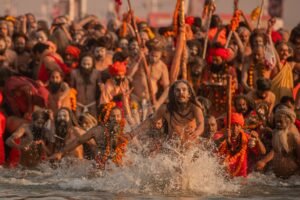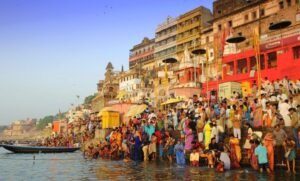Who Should Go To MahaKumbh Yatra
Maha Kumbh Yatra: The Grand Spiritual Confluence of Faith and Tradition
India, a land of diverse cultures and deep-rooted traditions, hosts one of the largest religious gatherings in the world—the Maha Kumbh Yatra. This grand event, which occurs once every 12 years, draws millions of pilgrims, saints, and tourists to the sacred confluence of rivers in four major cities: Prayagraj, Haridwar, Ujjain, and Nashik. The Maha Kumbh is a testament to unwavering faith, spiritual awakening, and the rich cultural heritage of India.
Origins and Mythological Significance

The origins of the Maha Kumbh Yatra are deeply embedded in Hindu mythology. According to ancient scriptures, the gods and demons churned the cosmic ocean (Samudra Manthan) in search of the elixir of immortality (Amrit). As the celestial pot (Kumbh) containing the nectar emerged, a fierce battle ensued between the two factions. During this battle, a few drops of Amrit fell on four earthly locations—Prayagraj (Allahabad), Haridwar, Ujjain, and Nashik. These sites became sacred pilgrimage destinations, and the tradition of Kumbh Mela was established, where devotees gather to cleanse their sins and attain spiritual liberation.
Types of Kumbh Melas
There are four types of Kumbh Melas celebrated in India:
- Maha Kumbh Mela – Occurs once every 144 years (12 Purna Kumbh cycles) at Prayagraj.
- Purna Kumbh Mela – Held every 12 years at each of the four holy locations.
- Ardh Kumbh Mela – Celebrated every six years in Prayagraj and Haridwar.
- Magh Mela (Mini Kumbh) – Takes place annually in Prayagraj, culminating in a grand gathering every 12 years.
The Sacred Sites of Maha Kumbh
- Prayagraj – The most significant Kumbh location, where the Ganga, Yamuna, and the mystical Saraswati rivers meet at Triveni Sangam.
- Haridwar – The gateway to the Ganges, where the river emerges from the Himalayas.
- Ujjain – Situated on the banks of the Kshipra River, associated with Lord Shiva.
- Nashik – Located on the Godavari River, deeply linked to Lord Rama’s exile.
How to Reach Maha Kumbh Yatra 2025
Reaching the Maha Kumbh Yatra requires careful planning due to the massive influx of devotees. Here are the best ways to get there:
- By Air: The nearest airports to Prayagraj are in Varanasi, Lucknow, and Kanpur. Special flights are often arranged during the Kumbh period.
- By Train: Prayagraj is well-connected by railway networks across India. The Indian Railways runs additional special trains to accommodate the high number of pilgrims.
- By Road: Highways leading to Kumbh cities witness heavy traffic. Government and private bus services, along with taxis, are widely available.
- By Water: Some pilgrims prefer to travel by boat along the Ganga to reach the event site.
Who Should Go and Who Should Not?
Maha Kumbh Yatra is a spiritually fulfilling but physically demanding pilgrimage. It is ideal for:
- Devotees seeking spiritual cleansing and religious enlightenment.
- Travelers and photographers interested in witnessing cultural diversity.
- Scholars and researchers studying religious and sociological aspects.
People who should reconsider or avoid the journey:
- Elderly individuals with serious health conditions.
- Pregnant women due to extreme crowding and lack of medical facilities.
- Those with mobility issues, as navigating large crowds and temporary accommodations can be difficult.
- Young children, unless they are closely supervised due to the risk of getting lost in massive gatherings.
Challenges and Difficulties in Maha Kumbh 2025
While the Maha Kumbh Yatra is a divine experience, it comes with numerous challenges:
- Road Traffic Congestion: With millions traveling by road, highways leading to Prayagraj and other Kumbh cities are heavily jammed. Authorities impose road diversions, causing long delays.
- Crowd Management: The event draws millions, making movement slow and sometimes dangerous. Managing queues for temple visits, bathing ghats, and food stalls requires patience.
- Lines in Temples: Waiting times at prominent temples and Akharas can stretch for hours. Special passes may be available for VIPs and international pilgrims.
- Accommodation Shortages: Hotels, dharamshalas, and tents fill up quickly. Booking well in advance is necessary to secure a comfortable stay.
- Hygiene and Sanitation: Temporary toilets and waste management systems are set up, but maintaining cleanliness is a challenge due to the sheer volume of visitors.
- Safety Concerns: Pickpocketing, stampedes, and health emergencies are potential risks. Carrying essentials and staying alert is crucial.
- Weather Conditions: January and February are cold in northern India. Pilgrims should prepare accordingly with warm clothing and necessary supplies.
The Grand Rituals of Maha Kumbh Yatra
The Maha Kumbh Yatra is marked by numerous rituals, each symbolizing purification and divine blessings:
- Shahi Snan (Royal Bath): The most significant event where saints and devotees take a dip in the sacred rivers, believing it washes away sins and grants salvation.
- Kalpavas: Devotees spend the entire month on the riverbanks, engaging in prayers, meditation, and simple living.
- Darshan of Akharas: Various sects of Hindu ascetics (Nagas, Sannyasis, Urdhwavahurs) participate in grand processions, displaying their unique traditions.
- Ganga Aarti: A mesmerizing ritual performed on the riverbanks, illuminating the night sky with thousands of lamps.
- Spiritual Discourses: Religious leaders, gurus, and scholars conduct sermons and debates on sacred texts, philosophy, and moral values.
The Maha Kumbh Yatra is not just a religious gathering; it is an extraordinary spiritual and cultural phenomenon. It encapsulates the essence of faith, unity, and devotion, drawing millions to its sacred waters. However, it comes with significant logistical challenges. Proper planning, awareness, and precautions can make the pilgrimage a more fulfilling experience. Whether one seeks divine blessings, cultural immersion, or a deep connection with humanity, the Maha Kumbh Yatra remains a once-in-a-lifetime event that transcends barriers and unites souls in the eternal quest for enlightenment


